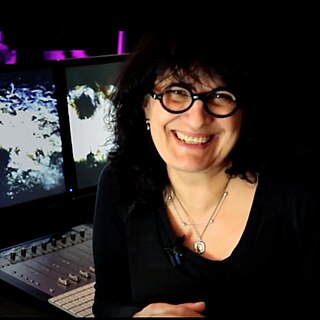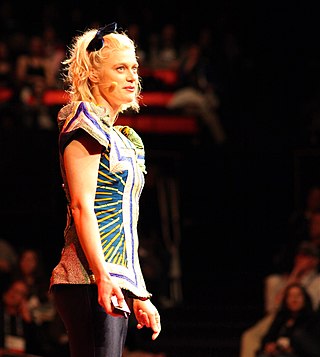
Ghulam Mohammed Sheikh is a painter, poet and art critic from Gujarat, India. He was awarded the Padma Shri in 1983 and Padmabhushan in 2014 for his contribution in field of art.

Alexis Jan Atthill Hunter was a New Zealand painter and photographer, who used feminist theory in her work. She lived and worked in London UK, and Beaurainville France. Hunter was also a member of the Stuckism collective. Her archive and artistic legacy is now administered by the Alexis Hunter Trust.
Faith Wilding is a Paraguayan American multidisciplinary artist - which includes but is not limited to: watercolor, performance art, writing, crocheting, knitting, weaving, and digital art. She is also an author, educator, and activist widely known for her contribution to the progressive development of feminist art. She also fights for ecofeminism, genetics, cyberfeminism, and reproductive rights. Wilding is Professor Emerita of performance art at the School of the Art Institute of Chicago.

Don Ed Hardy is an American tattoo artist known for his tattoos, strong influence on the development of modern tattoo styles, and his eponymous apparel and accessories brand.
Vyvyn Lazonga is a tattoo artist who began her career in Seattle in the early 1970s and was trained by Danny Danzl. She was the first woman to work for herself in the industry, not her husband or another male shop owner. She worked in San Francisco and was tattooed by Ed Hardy in the 70s. She won the award for Best Tattooed Female in 1978 for his work. Later she was fortunate enough to meet Horiyoshi II at one of Lyle Tuttle's parties before returning in 1989 to open her studio in Seattle.

Temple tanks are wells or reservoirs built as part of the temple complex near Indian temples. They are called pushkarini, kalyani, kunda, sarovara, tirtha, talab, pukhuri, ambalakkuḷam, etc. in different languages and regions of India. Some tanks are said to cure various diseases and maladies when bathed in. It is possible that these are cultural remnants of structures such as the Great Bath of Mohenjo-daro or Dholavira, which was part of the Indus Valley civilization. Some are stepwells with many steps at the sides.
Anita E. Kunz, OC, DFA, RCA is a Canadian-born artist and illustrator. She was the first woman and first Canadian to have a solo exhibit at the Library of Congress in Washington, D.C.

Sadia Sadia is a Canadian-born British installation artist, known for her audiovisual media work, incorporating sound and images, both still and moving.
Irene Barberis, is an Australian/British artist, based in Melbourne and London. She is a painter primarily, working also with installation, drawing, and new media art. She is also the founding director of an international arts research centre, and is an international curator and writer.
Hollis Sigler was an American artist. She received several Arts Lifetime Achievement awards as both an artist and an educator, including the Distinguished Artist Award for Lifetime Achievement from the College Art Association in 2001.
Melissa Chiu is an Australian museum director, curator and author, and the director of the Hirshhorn Museum and Sculpture Garden in Washington, DC.

Simone Leigh is an American artist from Chicago who works in New York City in the United States. She works in various media including sculpture, installations, video, performance, and social practice. Leigh has described her work as auto-ethnographic, and her interests include African art and vernacular objects, performance, and feminism. Her work is concerned with the marginalization of women of color and reframes their experience as central to society. Leigh has often said that her work is focused on “Black female subjectivity,” with an interest in complex interplays between various strands of history. She was named one of the 100 most influential people in the world by Time magazine in 2023.
Harriet Edquist is an Australian historian and curator, and Professor Emerita in the School of Architecture and Urban Design at RMIT University in Melbourne. Born and educated in Melbourne, she has published widely on and created numerous exhibitions in the field of Australian architecture, art and design history. She has also contributed to the production of Australian design knowledge as the founding editor of the RMIT Design Archives Journal and is a member of the Design Research Institute at RMIT University.
Julia Fish is an American artist whose paintings have a deceptive simplicity. She paints in oil on stretched rectangular canvases of varying size. By means of close observation of everyday subjects—leaves of a tree seen through a window, a section of floor tiles, an old fashioned light fixture— she makes, as one critic says, "quiet, abstract manifestations of observed realities." She is a studio artist who paints not what she sees in an instant but rather what she observes continuously, day after day. The result, she says, is not so much temporal as durational. Her paintings compress many instances of observation so as to become, as she sees it, "a parallel system to a lived experience." The paintings lack spatial orientation and, as a critic says, can "be described as both highly realistic and abstract without compromising either term." In 2008, Alan G. Artner, writing in the Chicago Tribune, said "This is work of small refinements and adjustments. The world of everyday things generates it, but Fish's qualities of seeing and touch elevate the things to a plane on which they leave behind their humble character."
Kate Just is an American-born Australian feminist artist. Just is best known for her inventive and political use of knitting, both in sculptural and pictorial form. In addition to her solo practice, Just often works socially and collaboratively within communities to create large scale, public art projects that tackle significant social issues including sexual harassment and violence against women.
Torkwase Dyson is an interdisciplinary artist based in Beacon, New York, United States. Dyson describes the themes of her work as "architecture, infrastructure, environmental justice, and abstract drawing." Her work is informed by her own theory of Black Compositional Thought. This working term considers how spatial networks—paths, throughways, water, architecture, and geographies—are composed by Black bodies as a means of exploring potential networks for Black liberation. She is represented by Pace Gallery and Richard Gray Gallery.

Lucy McRae is a British-born Australian science fiction artist, body architect, film maker and TED fellow. Her installations include film, photography, sculptures, and edible and wearable technology.
Kari Barba is an American tattoo artist and painter from Minneapolis. Barba has been practicing art for over 40 years and is best known for her work for women within the tattoo industry. Barba is based in Long Beach, California. She is the owner of Outer Limits Tattoo, the oldest tattoo shop in the United States.
Tejal Shah is an Indian contemporary visual artist and curator. She works within the mediums of video art, photography, performance, drawing, sound work, and spatial installations. Shah explores topics in her work including the LGBTQ+ community, sexuality, gender, disability, and the relationship between humans and nature. She lives in Mumbai.






